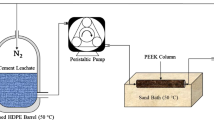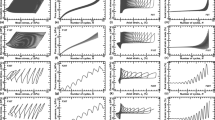Abstract
Differences in the properties of clay minerals cause formation damage under the condition of thermal production in heavy-oil reservoirs; asphaltenes adsorbed on clay minerals exacerbate the formation damage. The purpose of the present study was to reveal the variation in clay minerals and the adsorption behavior of asphaltenes on clay mineral surfaces under thermal recovery conditions. Volume changes and transformations of typical clay minerals were studied under various conditions (80 and 180°C, pH 9 and 11, aqueous and oven-dry conditions). On this basis, the adsorption behavior and mechanism of asphaltenes on the surfaces of clay minerals in various simulated conditions were investigated. The adsorption mechanism was revealed using kinetics and isothermal adsorption models. The results showed that the volume of montmorillonite expanded by up to 159.13% after water–rock interaction at 180°C with pH 11; meanwhile, the conversion rates of kaolinite and illite to montmorillonite were 6.6 and 7.8%, respectively. The water–rock interaction intensified the volume changes and transformations of clay minerals under thermal conditions. The amounts of asphaltene adsorbed on clay minerals at 180°C were greater than those at 80°C. The adsorption process of asphaltenes was inhibited under aqueous conditions. The abilities of the constituent minerals to bind asphaltenes was in order: montmorillonite > chlorite > kaolinite > illite > quartz sand. The adsorption process of asphaltenes yielded high coefficients of regression with both the Freundlich and Langmuir models under oven-dry (>0.99) and aqueous (>0.98) conditions. At 180°C under aqueous conditions, the water film significantly inhibited the adsorption of asphaltene on the clay minerals. The adsorption process of asphaltenes, therefore, could be regarded as the adsorption occurring at lower concentrations under oven-dry conditions.










Similar content being viewed by others
Data Availability
All data analysed during this study are included in this published article (and its supplementary information files).
References
Adams, J. J. (2014). Asphaltene adsorption, a literature review. Energy & Fuels, 28(5), 2831–2856. https://doi.org/10.1021/ef500282p
Afsar, C., & Akin, S. (2016). Solar generated steam injection in heavy oil reservoirs: A case study. Renewable Energy, 91, 83–89. https://doi.org/10.1016/j.renene.2016.01.047
Al-Duri, B. (1995). A review in equilibrium in single and multicomponent liquid adsorption systems. Reviews in Chemical Engineering, 11(2), 101–144. https://doi.org/10.1515/REVCE.1995.11.2.101
Alagumuthu, G., & Rajan, M. (2010). Equilibrium and kinetics of adsorption of fluoride onto zirconium impregnated cashew nut shell carbon. Chemical Engineering Journal, 158(3), 451–457. https://doi.org/10.1016/j.cej.2010.01.017
Baker, J. C., Grabowska-Olszewska, B., & Uwins, P. J. R. (1995). ESEM study of osmotic swelling of bentonite from Radzionkow (Poland). Applied Clay Science, 9(6), 465–469. https://doi.org/10.1016/0169-1317(95)00002-L
Bantignies, J.-L., Dit Moulin, C. C., & Dexpert, H. (1997). Wettability contrasts in kaolinite and illite clays: Characterization by infrared and X-ray absorption spectroscopies. Journal de Physique IV France, 7(C2), 867–869. https://doi.org/10.1051/jp4:1997261
Bentabol, M., Ruiz Cruz, M. D., Huertas, F. J., & Linares, J. (2006). Chemical and structural variability of illitic phases formed from kaolinite in hydrothermal conditions. Applied Clay Science, 32(1–2), 111–124. https://doi.org/10.1016/j.clay.2005.12.003
Bhaumik, R., Mondal, N. K., Das, B., Roy, P., Pal, K. C., Das, C., Baneerjee, A., & Datta, J. k. (2012). Eggshell powder as an adsorbent for removal of fluoride from aqueous solution: Equilibrium, kinetic and thermodynamic studies. Journal of Chemistry, 9(3), 1457–1480. https://doi.org/10.1155/2012/790401
Bradley, H. (1927). Adsorption isothermals. Nature, 120(3011), 82 https://www.nature.com/articles/120082a0.pdf
China National Petroleum Corporation. (1995). X-ray diffraction analysis method for relative content of clay minerals in sedimentary rocks (Standard no. SY/T 5163-1995).
China Petrochemical Corporation. (1992). Determination of asphaltenes in crude oil (Standard no. SH/T 0266-1992).
Daughney, C. J. (2000). Sorption of crude oil from a non-aqueous phase onto silica: The influence of aqueous ph and wetting sequence. Organic Geochemistry, 31(2–3), 147–158. https://doi.org/10.1016/S0146-6380(99)00130-8
Dean, K. R., & McAtee Jr., J. L. (1986). Asphaltene adsorption on clay. Applied Clay Science, 1(4), 313–319. https://doi.org/10.1016/0169-1317(86)90008-6
di Primio, R., Horsfield, B., & Guzman-Vega, M. A. (2000). Determining the temperature of petroleum formation from the kinetic properties of petroleum asphaltenes. Nature, 406, 173–176.
Dong, X., Liu, H., Chen, Z., Wu, K., Lu, N., & Zhang, Q. (2019). Enhanced oil recovery techniques for heavy oil and oilsands reservoirs after steam injection. Applied Energy, 239, 1190–1211. https://doi.org/10.1016/j.apenergy.2019.01.244
Dubey, S. T., & Waxman, M. H. (1991). Asphaltene adsorption and desorption from mineral surfaces. SPE Reservoir Engineering, 6(03), 389–395. https://doi.org/10.2118/18462-PA
Duran, J. A., Casas, Y. A., Xiang, L., Zhang, L., Zeng, H., & Yarranton, H. W. (2019). Nature of asphaltene aggregates. Energy & Fuels, 33(5), 3694–3710. https://doi.org/10.1021/acs.energyfuels.8b03057
El-Khaiary, M. I., Malash, G. F., & Ho, Y.-S. (2010). On the use of linearized pseudo-second-order kinetic equations for modeling adsorption systems. Desalination, 257(1–3), 93–101. https://doi.org/10.1016/j.desal.2010.02.041
Feng, D., Li, X., Wang, X., Li, J., Sun, F., Sun, Z., Zhang, T., Li, P., Chen, Y., & Zhang, X. (2018). Water adsorption and its impact on the pore structure characteristics of shale clay. Applied Clay Science, 155, 126–138. https://doi.org/10.1016/j.clay.2018.01.017
Filipská, P., Zeman, J., Všianský, D., Honty, M., & Škoda, R. (2017). Key processes of long-term bentonite-water interaction at 90°C: Mineralogical and chemical transformations. Applied Clay Science, 150, 234–243. https://doi.org/10.1016/j.clay.2017.09.036
Freundlich, H. (1935). Adsorptionstechnik. By Franz Krzil. Journal of Physical Chemistry, 40(6), 857–858. https://doi.org/10.1021/j150375a022
Gonzalez, V., & Taylor, S. E. (2016). Asphaltene adsorption on quartz sand in the presence of pre-adsorbed water. Journal of Colloid and Interface Science, 480, 137–145. https://doi.org/10.1016/j.jcis.2016.07.014
Herron, M. M. (1986). Mineralogy from geochemical well logging. Clays and Clay Minerals, 34(2), 204–213. https://doi.org/10.1346/CCMN.1986.0340211
Hosseini-Dastgerdi, Z., & Meshkat, S. S. (2019). An experimental and modeling study of asphaltene adsorption by carbon nanotubes from model oil solution. Journal of Petroleum Science and Engineering, 174, 1053–1061. https://doi.org/10.1016/j.petrol.2018.12.024
Hurst, A., & Archer, J. S. (1986). Sandstone reservoir description: An overview of the role of geology and mineralogy. Clay Minerals, 21(4), 791–809. https://doi.org/10.1180/claymin.1986.021.4.21
Jafari Behbahani, T., Ghotbi, C., Taghikhani, V., & Shahrabadi, A. (2013). Asphaltene deposition under dynamic conditions in porous media: Theoretical and experimental investigation. Energy & Fuels, 27(2), 622–639. https://doi.org/10.1021/ef3017255
Kar, T., Mukhametshina, A., Unal, Y., & Hascakir, B. (2015). The effect of clay type on steam-assisted-gravity-drainage performance. Journal of Canadian Petroleum Technology, 54(06), 412–423. https://doi.org/10.2118/173795-PA
Kashefi, S., Lotfollahi, M. N., & Shahrabadi, A. (2019). Asphaltene adsorption using nanoparticles with different surface chemistry: Equilibrium and thermodynamics studies. Petroleum Chemistry, 59, 1201–1206. https://doi.org/10.1134/S0965544119110124
Kazempour, M., Sundstrom, E., & Alvarado, V. (2012). Geochemical modeling and experimental evaluation of high-pH floods: Impact of water-rock interactions in sandstone. Fuel, 92(1), 2016–2230. https://doi.org/10.1016/j.fuel.2011.07.022
Kong, B., Wang, S., & Chen, S. (2017). Minimize formation damage in water-sensitive Montney formation with energized fracturing fluid. SPE Reservoir Evaluation & Engineering, 20(03), 562–571. https://doi.org/10.2118/179019-PA
Kord, S., Mohammadzadeh, O., Miri, R., & Soulgani, B. S. (2014). Further investigation into the mechanisms of asphaltene deposition and permeability impairment in porous media using a modified analytical model. Fuel, 117(A), 259–268. https://doi.org/10.1016/j.fuel.2013.09.038
Kudrashou, V. Y., & Nasr-El-Din, H. A. (2020). Formation damage associated with mineral alteration and formation of swelling clays caused by steam injection in sandpacks. SPE Reservoir Evaluation & Engineering, 23(01), 326–344. https://doi.org/10.2118/195700-PA
Langmuir, I. (1932). Vapor pressures, evaporation, condensation and adsorption. Journal of the American Chemical Society, 54(7), 2798–2832. https://doi.org/10.1021/ja01346a022
Lei, H., Yang, S., Qian, K., Chen, Y., Li, Y., & Ma, Q. (2015). Experimental investigation and application of the asphaltene precipitation envelope. Energy & Fuels, 29(11), 6920–6927. https://doi.org/10.1021/acs.energyfuels.5b01237
Li, X., Bai, Y., Sui, H., & He, L. (2017). Understanding the liberation of asphaltenes on the muscovite surface. Energy & Fuels, 31(2), 1174–1181. https://doi.org/10.1021/acs.energyfuels.6b02278
Lopes da Silva, M., Martins, J. L., Ramos, M. M., & Bijani, R. (2018). Estimation of clay minerals from an empirical model for cation exchange capacity: An example in Namorado oilfield, Campos Basin, Brazil. Applied Clay Science, 158, 195–203. https://doi.org/10.1016/j.clay.2018.02.040
Mansoori Mosleh, F., Mortazavi, Y., Hosseinpour, N., & Khodadadi, A. A. (2020). Asphaltene adsorption onto carbonaceous nanostructures. Energy & Fuels, 34(1), 211–224. https://doi.org/10.1021/acs.energyfuels.9b03466
Moreno-Arciniegas, L., & Babadagli, T. (2014). Optimal application conditions of solvent injection into oil sands to minimize the effect of asphaltene deposition: An experimental investigation. SPE Reservoir Evaluation & Engineering, 17(04), 530–546. https://doi.org/10.2118/165531-PA
Morodome, S., & Kawamura, K. (2009). Swelling behavior of Na-and Ca-montmorillonite up to 150°C by in situ X-ray diffraction experiments. Clays and Clay Minerals, 57, 150–160. https://doi.org/10.1346/CCMN.2009.0570202
National Energy Administration. (2016). Shale expansion tester (Standard no. SY/T 7327-2016).
Pang, Z., Lyu, X., Zhang, F., Wu, T., Gao, Z., Geng, Z., & Luo, C. (2018). The macroscopic and microscopic analysis on the performance of steam foams during thermal recovery in heavy oil reservoirs. Fuel, 233(1), 166–176. https://doi.org/10.1016/j.fuel.2018.06.048
Piro, G., Canonico, L. B., Galbariggi, G., Bertero, L., & Carniani, C. (1996). Asphaltene adsorption onto formation rock: An approach to asphaltene formation damage prevention. SPE Production & Facilities, 11(03), 156–160. https://doi.org/10.2118/30109-PA
Rogel, E. (2002). Asphaltene aggregation: A molecular thermodynamic approach. Langmuir, 18(5), 1928–1937. https://doi.org/10.1021/la0109415
Sauer, K., Caporuscio, F., Rock, M., Cheshire, M., & Jové-Colón, C. (2020). Hydrothermal interaction of Wyoming bentonite and opalinus clay. Clays and Clay Minerals, 68, 144–160. https://doi.org/10.1007/s42860-020-00068-8
Skipper, N. T., Sposito, G., & Chang, F.-R. C. (1995). Monte Carlo simulation of interlayer molecular structure in swelling clay minerals. 2. Monolayer hydrates. Clays and Clay Minerals, 43, 294–303. https://doi.org/10.1346/CCMN.1995.0430304
Sudhakar, M. R., & Thyagaraj, T. (2007). Role of direction of salt migration on the swelling behaviour of compacted clays. Applied Clay Science, 38, 113–129. https://doi.org/10.1016/j.clay.2007.02.005
Wu, G., He, L., & Chen, D. (2013). Sorption and distribution of asphaltene, resin, aromatic and saturate fractions of heavy crude oil on quartz surface: Molecular dynamic simulation. Chemosphere, 92(11), 1465–1471. https://doi.org/10.1016/j.chemosphere.2013.03.057
Yang, Y., Li, Y., Yao, J., Zhang, K., Iglauer, S., Luquot, L., & Wang, Z. (2019). Formation damage evaluation of a sandstone reservoir via pore-scale X-ray computed tomography analysis. Journal of Petroleum Science and Engineering, 183, 106356. https://doi.org/10.1016/j.petrol.2019.106356
Zhao, D. W., Wang, J., & Gates, I. D. (2014). Thermal recovery strategies for thin heavy oil reservoirs. Fuel, 117(A), 431–441. https://doi.org/10.1016/j.fuel.2013.09.023
Zhuang, Y., Liu, X., Xiong, H., & Liang, L. (2018). Microscopic mechanism of clay minerals on reservoir damage during steam injection in unconsolidated sandstone. Energy & Fuels, 32(4), 4671–4681. https://doi.org/10.1021/acs.energyfuels.7b03686
Acknowledgments
This study was supported financially by the National Natural Science Foundation of China (Grant No. 52004216, No. 52004217, No. 51874240, No. 51804256, No. 51804041) and Scientific Research Projects of Shaanxi Provincial Department of Education (No. 20JS119, No. 20JK0829). Shaanxi Province Key Research and Development Plan (No. 2020KW-027).
Funding
Funding sources are as stated in the Acknowledgments.
Author information
Authors and Affiliations
Corresponding author
Ethics declarations
Conflict of Interest
The authors declare that they have no conflict of interest.
Rights and permissions
About this article
Cite this article
He, Y., Niu, W., Gao, Z. et al. Adsorption Behavior of Asphaltene on Clay Minerals and Quartz in a Heavy Oil Sandstone Reservoir with Thermal Damage. Clays Clay Miner. 70, 120–134 (2022). https://doi.org/10.1007/s42860-022-00178-5
Accepted:
Published:
Issue Date:
DOI: https://doi.org/10.1007/s42860-022-00178-5




